NBB Controls Components NLSMJ430 NANO-L SMJ43 User Manual Nano L SMJ USA Canada Zulassung 10 15
NBB Controls + Components AG NANO-L SMJ43 Nano L SMJ USA Canada Zulassung 10 15
User Manual
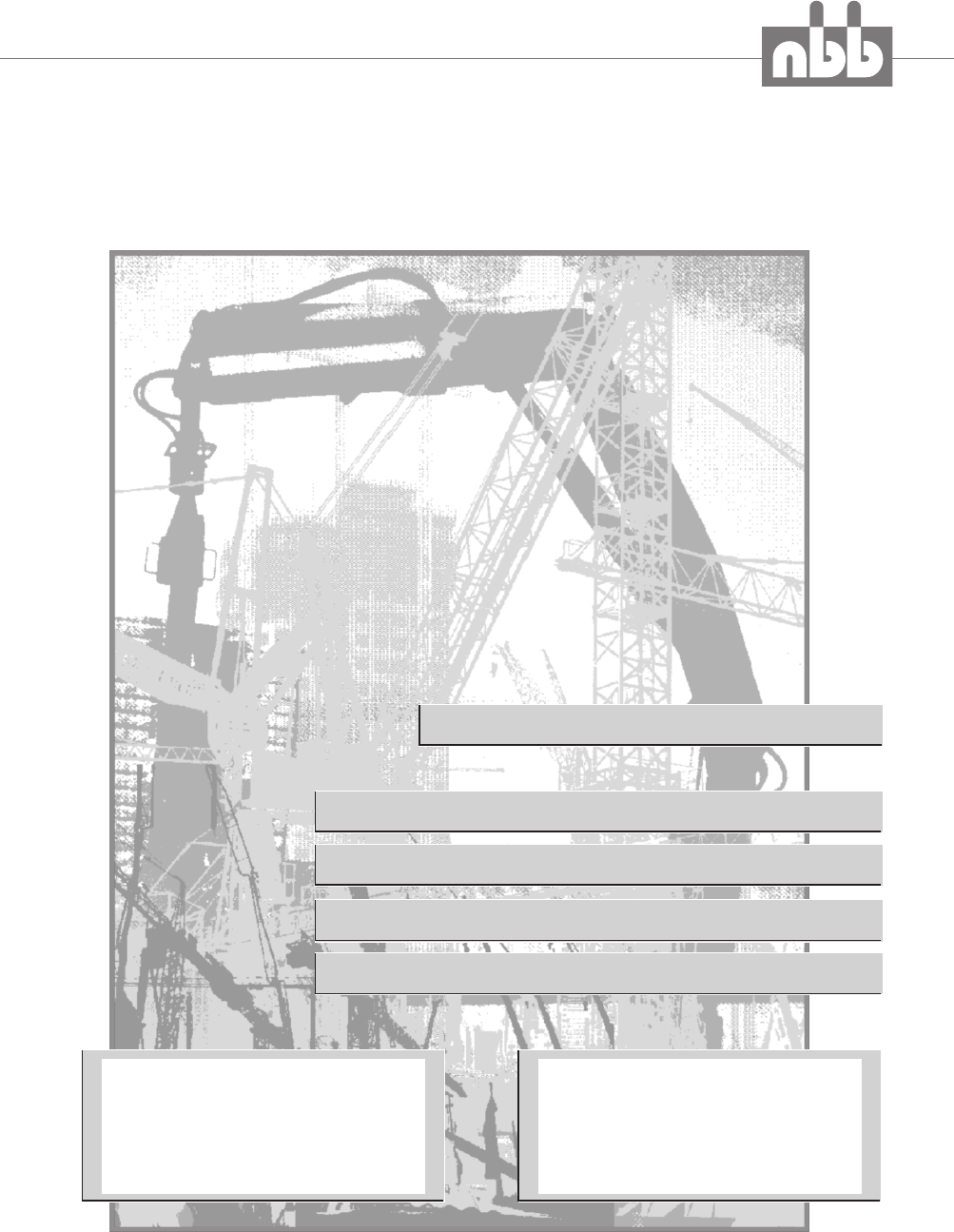
OPERATING INSTRUCTIONS
®
Receiver Type / Version
Factory No.
Frequency
Transmitter Type / Version
Factory No.
Frequency
X X X
Nano-L SMJ USA/Canada
Compact-M, Compact-M2
R-18, R-CAN
Receiver
Compact-V, PNN-BUS-3
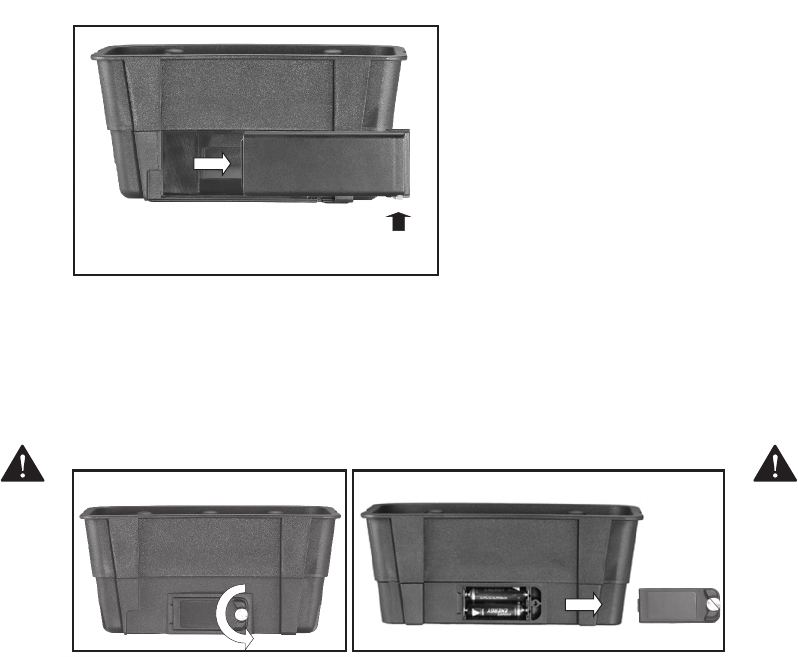
%Portable transmitter.
%Receiver with integrated mounting holes.
%Multi-pin connecting cable for the receiver according to your specifications.
The actual delivery specification is as detailed on the confirmation of order or
the delivery note accompanying the goods!
Even if you are accustomed to working with radio control systems, read these
operating instructions carefully before using this equipment. Only this docu-
ment contains the latest information relating to your NBB radio control system.
For explanatory notes on obtaining an operating permit please refer to registration docu-
ments enclosed in the appendix of this operating instruction. Observe all applicable work-
safety and accident prevention regulations carefully. Only fully trained, authorized per-
sonnel may use the NBB radio control equipment. Components, etc. built into the NBB
equipment for safety purposes must be regularly inspected.
If the NBB radio control unit develops a fault, it must be shut down immediately.
The transmitter should be switched off with the STOP key, resp. EMERGENCY
STOP switch. The connecting cable must be disconnected at the receiver from
the connecting socket (terminal) of the unit to be controlled . The repair of the
equipment must not be carried out other than by NBB or an NBB authorized tech-
nician.
Failure to observe these recommendations will put both you yourself and others at risk.
Under these circumstances, NBB rescinds the guarantee and any other form of liability.
This radio control unit is designed exclusively for the control of construction machines
and industrial plants. Only under these conditions are the safety systems (STOP, resp.
EMERGENCY STOP, zero setting) fully effective. No other form of use is permitted. Any
non-observance of this condition will relieve NBB of all liability.
1. STANDARD SPECIFICATION
2. SAFETY PRECAUTIONS
3. TRANSMITTER
7,2V: To make the unit ready for use, insert the battery into the battery
Compartment. To remove the battery, press in the pin and push out the battery.
Press in the pin
and push out the battery
2,4V: To make the unit ready for use, unscrew the screw plug of the battery compart-
ment on the back of the transmitter and remove the cover. Insert 2 charged AA Mignon bat-
teries 1,2V NiMH (or batteries 1,5V - not rechargeable) into the battery compartment, clo-
se the cover and tighten the screw plug again.
Rechargeable batteries (NiMH or NiCd) must be fully charged before first use!
Never attempt to charge standard non rechargeable 1,5V AA batteries!
Switching on:

START
STOP
Transmitter with Emergency-Stop switch
As a confirmation the horn will be activated briefly two times in a row.
As a confirmation the horn will be activated briefly one time long continuous.
The power supply to the transmitter is activated with the “STOP” key, resp.
EMERGENCY STOP switch. (When pressed, the EMERGENCY STOP switch can
also be secured by removing the key cap. EMERGENCY STOP key No. 19 ).
A red dot flashes on the Planar- NL / Nano-L display during operation.
Commands can now be put in by means of the controls.
To turn off the transmitter push the “EMERGENCY STOP” switch.
START
START
STOP
Transmitter with Piezo button
As a confirmation the horn will be activated briefly two times in a row.
As a confirmation the horn will be activated briefly one time long continuous.
The power supply to the transmitter is activated with the “STOP” key and the ON/HORN
key. The order you push the keys doesn´t make any difference. After you push the first
key, you have 5 seconds to push the second key.
A red dot flashes on the Planar- NL / Nano-L display during operation.
Commands can now be put in by means of the controls.
To turn off the transmitter push the “STOP” key.
Option: Turn the switch on the side to position: ON
When the letter "L" flashes quickly on the Nano-L display, the battery are nearly empty.
The transmitter can be operated for approximately 30 minutes more in this condition.
During this time, bring the unit to a safe position, switch off the transmitter and install a
charged battery.
Energy saving function: The transmitter switches off automatically, if the keys are not
pressed within a specified time. The red dot goes out.
Optional: Transmitter for continuous operation possible.
*The duration of this stand-by can be specified when ordering.
.
.
.
.
Operation:
The red dot flashes.
Quickly flashing:
Batteries are nearly
empty. Transmitter can
be operated for appr.
30 minutes more.
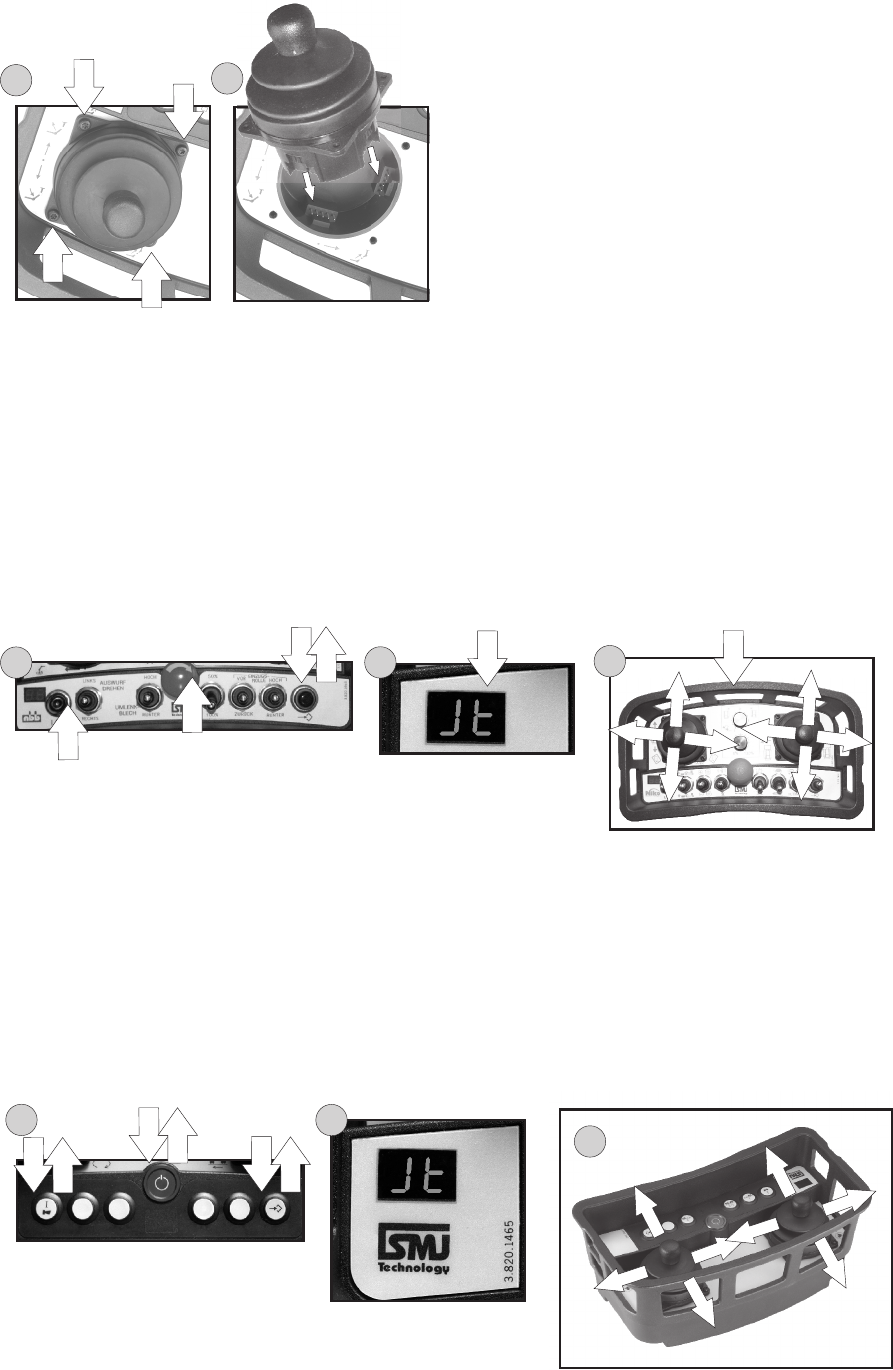
Changing the Joysticks: Unscrew and remove the 4 screws from
the joystick
(witch a Torx T10 screwdriver) (1) and move out the joystick.
Insert the new joystick. Attend the orientation from the connectors
(2).
Fix the joystick with the 4 screws.
After the changing, start the joystick teachmode.
12
Joystick teach mode activation EMERGENCY STOP switch:
• Before starting the joystick teach mode activation, please switch off
1. Push the “Frequency change” button and hold it.
2. Release the “Stop” button.
3. After a while “Jt” should be shown on the display. Now release the “Frequency change” button.
4. Please deflect all joysticks as much as possible in the same directions as shown.
5. Push the “On/Horn” button..
6. Release the “On/Horn” button.
• Troubleshooting:
If “Jt” couldn't be shown on the display please switch off the transmitter and repeat the teach mode activation procedure.
23
1
2
4
1
5
33
2
3
1
2
4
15
36
Joystick teach mode activation with Piezo:
• Before starting the joystick teach mode activation, please switch off the transmitter!!!
1. Push the “Frequency change” button and hold it.
2. Push the PIEZO and the ON/HORN buttons
3. After a while “Jt” should be shown on the display. Now release the button “Frequency change”.
4. Please deflect all joysticks as much as possible in the same directions as shown.
5. Press the ON/HORN button. Attention! Now the transmitter is on the working mode!
A red dot flashes on the display during operation.
• Troubleshooting:
If “Jt” couldn't be shown on the display please switch off the transmitter and repeat the teach mode activation procedure.
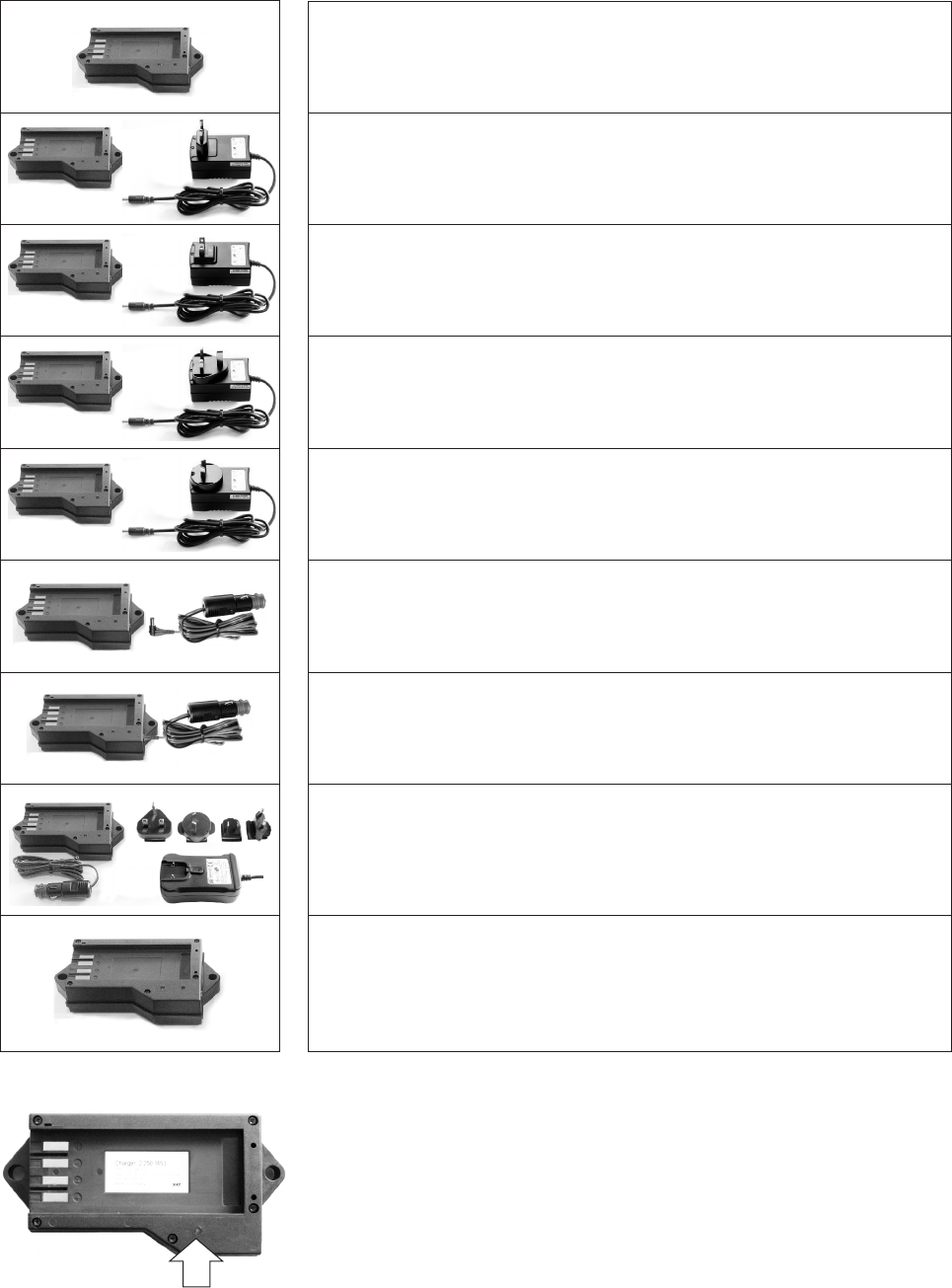
For charging NiCd and NiMH batteries (7,2V).
Optional: Integrated battery charger if DC-supply: In the receivers R-16, R-CAN, Com-
pact-M and Compact-V rapid charging in about 1 hour. In PNN-BUS-3 about 3 hours.
Use this battery charger only in closed rooms.
BATTERY CHARGER
L-AD72A2
2.250.1449 Universal-charger (12V/24V DC),
(without cable), black
2.250.1451 Universal-charger (2.250.1449) (12V/24V DC)
set with 2m cable, black, pluggable at the charger,
with car charger (cigarette lighter) (3.400.1451)
2.250.1452 Universal-charger (2.250.1449) (12V/24V DC)
set with 2m cable, black, not pluggable at the charger,
only for car charger,
with car charger (cigarette lighter) (3.400.1451)
2.250.1453 Universal-charger (2.250.1449) (12V/24V DC)
set, black, included: car charger (cigarette lighter) (3.400.1451),
interchangeable ac plugs (GB, Australia, USA/Japan, Europe)
(3.970.1456) and power supply (3.970.1455)
(100/240V AC / 12V DC)
2.251.1450 Universal-charger (2.250.1449) (12V/24V DC)
set with 2m cable, black, pluggable with plug
USA/Japan (3.970.1451) and power supply (3.970.1448)
(100/240V AC / 12V DC)
2.252.1450 Universal-charger (2.250.1449) (12V/24V DC)
set with 2m cable, black, pluggable with plug
GB (3.970.1452) and power supply (3.970.1448)
(100/240V AC / 12V DC)
2.253.1450 Universal-charger (2.250.1449) (12V/24V DC)
set with 2m cable, black, pluggable with plug
Australia (3.970.1453) and power supply (3.970.1448)
(100/240V AC / 12V DC)
2.250.1450 Universal-charger (2.250.1449) (12V/24V DC)
set with 2m cable, black, pluggable with plug
Europe (3.970.1449) and power supply (3.970.1448)
(100/240V AC / 12V DC)
2.250.1455 Universal-charger/EX
black, pluggable, optional with plug Europe (3.970.1449) and
power supply (3.970.1448) or car charger (cigarette lighter)
(3.400.1451) (100/240V AC / 12V DC) Only to be used
outside the potentially explosive area!
LED
Operating instructions Display of the charging process via a DUO-LED:
Green LED - Steady light: STANDBY. The battery charger is ready for use.
Place the battery in the charger.
Orange LED - Steady light: CHARGING. The battery will now be charged.
Orange LED - Quickly flashing: The charging process is finished.
Orange LED - Slowly flashing: The battery is totally discharged or the ambient
temperature is to low for quick charging.
A regeneration respectively a warm-up stage
occurs with a reduced charging current until it
proceeds to the actual quick charging stage.
No harm will come to the battery if it is left in the charger beyond the required char-
ging time. Use this battery charger only in closed and dry rooms!
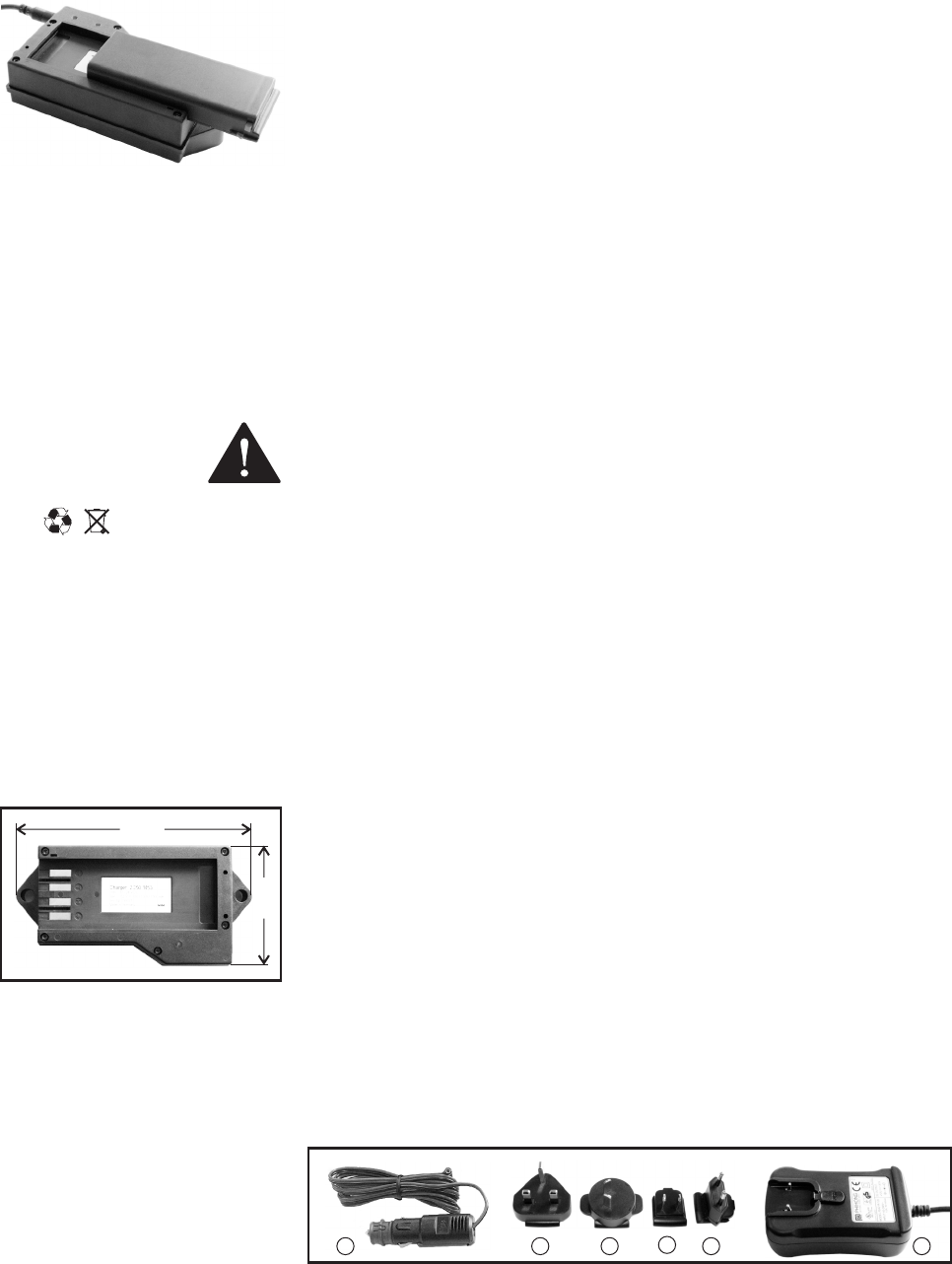
Before first use, fully charge batteries!
To prevent damage to the batteries never use discharged batteries!
Only charge fully discharged batteries!
Therefore please work with your control until the capacity of the battery is totally exhaus-
ted.
The battery reaches the maximum energy storage capacity only after at least 5 times char-
ging and discharging completely!
Discharge the battery completely in the operating unit before charging once more. The
charging time depends on the type of battery. It is normal that the battery warms up
during charging or longer use. Charge the battery in an ambient temperature range of
10°C up to 35°C. To avoid deep discharging the battery should be charged frequently
once a month. No legal liability for follow-up damages. Deep discharging and extreme
temperature damages the battery. Especially heat reduces the efficiency. If the tempe-
rature of the battery is too high or too low the charging process will not start to pro-
long the durability of the battery.
Keep the battery in the charged state in a cool and dry place.
Do not open, modify or burn the battery. Do not drop the battery and don't expose it to
blows or knocks. Protect the battery against rain, wetness or extreme temperature. Keep
the contacts clean and don't get the battery in touch with metal objects (aluminium foil
etc.). Do not short-circuit the battery.
A charged battery is a concentrated energy source. Never store a charged bat-
tery in a toolbox or similar where it could be short-circuited by metal compo-
nents (even a key in your trouser pocket can cause a short circuit).
Do not drop used up batteries into the domestic waste. Hand over the batteries to collecti-
ve point.
By damages, defects or premature wear caused by non-observance of the above descri-
bed operating and safety instructions all warranty claims expire.
Power supply via 12V / 24V on board or external power supply.
Range of voltage: 9V - 32VDC (Note: Below 10V the charging process takes longer).
Power supply via hollow plug (Outside diameter = 5,5mm, inside diam. - = 2,1mm)
The parameters of specific accumulators can be adjusted (Delta Peak, dT/dt, charg-
ing current, timeout)
AD-changer: 10Bit resolution
Identification of charging stop by:
Delta Peak (minus Delta U to maximum voltage)
dT/dt (Velocity of rise in temperature)
Timeout (shut down of time of charging)
Identification and evaluation of the following starting states:
Undervoltage: Pre-charging with reduced charging current
Untertemperatur: Pre-charging with reduced charging current (warm-up)
Overvoltage: No starting of the charging prosess
Shut down after reaching the maximum of temperatur.
Error memory to collect data of abort of charging.
1. Car charger (cigarette lighter) (3.400.1451), interchangeable ac plugs
(2. GB (3.970.1452), 3. Australia (3.970.1453), 4. USA/Japan (3.970.1451),
5. Europe (3.970.1449)) and 6. Power pack (3.970.1448).
Components:
Technical data
Warranty
Waste disposal
Safety precautions
175 mm
87 mm
Dimensions: 175 x 87 x 43 mm
7,2 V Battery
1. 2. 3. 4. 5. 6.
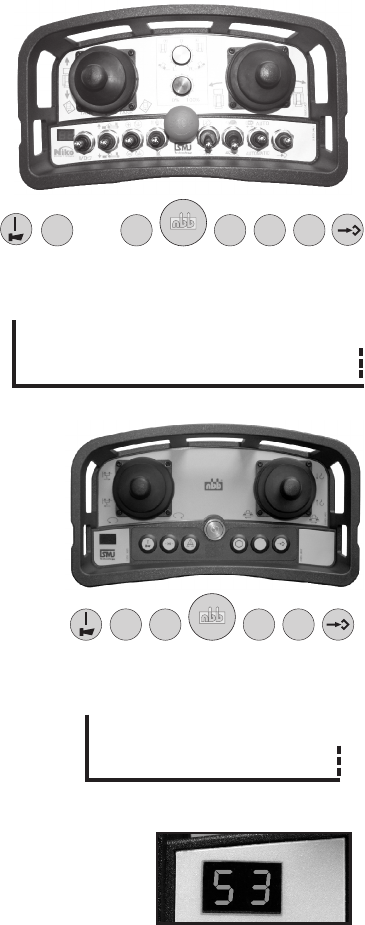
Safety equipment in the NBB-radio remote control:
In the transmitter, this comprises mainly:
%STOP, resp. EMERGENCY STOP with disconnection of the power supply.
%Automatic zero positioning.
In the receiver:
%Automatic zero setting when switching back on after radio interruption.
%Locking of the radio commands at relay level in the event of a defective STOP, resp.
EMERGENCY STOP circuit.
To ensure fault-free operation, please follow precisely the following rules for operation:
The unit to be controlled can only be switched on - it is assumed that the transmitter is
ready to operate - when no command unit is actuated. The command necessary to do so
is triggered by the key "ON/HORN". This triggers a horn signal in the unit to be controlled.
After switch-on of the facility to be controlled, this key is used for repeated emission of the
horn signal in accordance with working regulations.
If the NBB radio remote control is not used for a long period, it is urgently recom-
mended - if you use rechargeable batteries - that they should be charged now
and again (about every 4 weeks). This prevents deep discharges of the batteries
and prolongs their useful life. If you shut down the NBB radio remote control for a
long period, we recommend you take the batteries out of the transmitter.
Frequency change:
To change the frequency, keep the "ON/HORN" key pressed down. T h e n o p e r a t e t h e
“FREQUENCY CHANGE" key. If the receiver locks into the new frequency, a horn signal is
given (if present) and the unit to be controlled is ready for operation.
Please observe the particular postal approval regulations of the concerned country.
Channel number: When changing the frequency the channel number lights up shortly in
the display. During operation the choosen channel can be shown by pressing the
“FREQUENCY CHANGE” key.
(See example on the left)
4. OPERATING THE UNIT
FREQUENCY CHANGE
ON/HORN
FREQUENCY
CHANGE
ON/HORN
FREQUENCY
CHANGE
FREQUENCY CHANGE
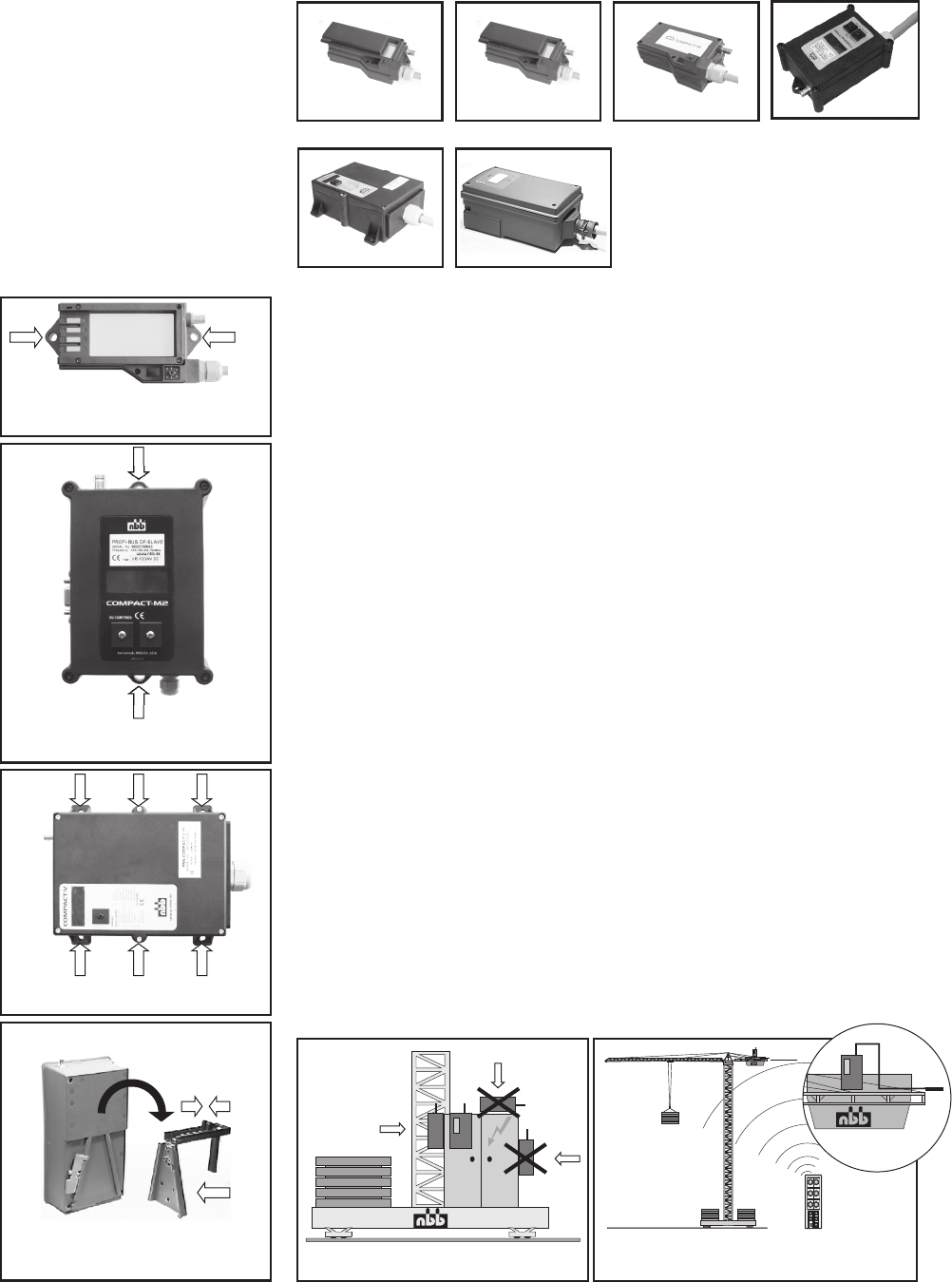
Compact-M2
5. RECEIVER
R-18,
R-CAN,
Compact-M,
Compact-M2,
Compact-V
PNN-BUS-3
Mounting possibility of the receiver
R-18, R-CAN,Compact-M.
Mounting possibility of the receiver
Compact-V.
.
WRONG
Mounting on a tower slewing crane.
Top slewing crane: Mount the antenna with
extension cable horizontally.
RIGHT
The receiver is connected to the unit to be controlled with the multi-pin connecting
cable supplied. Please observe the instructions issued by the manufacturer of the unit
to be controlled! We recommend urgently to realize this connection via a cen-
tral, well accessible, multi-pin plug connector (for example HTS-plug connec-
tor series HE/HB/HN/HA or comparable ones of other manufacturers) to
make possible a quick and clear fault diagnosis in the service case and to
take off the receiver without an expenditure of assembly.
The power supply of the receiver is generally effected by the connecting cable.
%In general, an earth lead is required in case the units to be controlled
have not previously been operated by radio control. Failing this, the
receiver electronic circuit will not receive any power supply. Ensure that
the operating voltage of the receiver complies with the electrical specifi-
cations of the unit to be controlled. The applicable operating voltage is
specified in the supplement.
%Never expose the receiver to a high pressure cleaning jet. This applies to
the transmitter also.
%The receiver should always be fixed vertically at the outside panel of the
switching cabinet. (The antenna should always reach over the top of the
panel.)
%You have to make sure that the antenna is not shielded by metal parts
totally or partly.
%Mounting the receiver in a cabine or in a switching cabinet the antenna
should be layed with an extension cable to the outside and be attached with
the fastening strapping as horizontally as possible with distance to the
shielding metal parts.
%In general the antenna should always be mounted in such a way so that the
antenna is still visible with each change of position of the transmitter.
WRONG
RIGHT
Compact-MR-18 R-CAN
Compact-V
Mounting possibility of the receiver
Compact-M2.
PNN-BUS-3
Mounting possibility of the
PNN-BUS-3.

Checking the LED display at the receiver R-18 and R-CAN:
(Optional with integrated charger)
The green LED flashes: RADIO PRESENT.
If the LED fails to come on:
1. Check that the transmitter is on.
2. Check the power supply of the receiver.
3. (Optional) Irregular flashing of the LED:
Check or change the current radio channel.
Checking the LED display at the receiver Compact-M:
(Without integrated charger)
The green LED flashes: RADIO PRESENT.
If the LED fails to come on:
1. Check that the transmitter is on.
2. Check the power supply of the receiver.
3. (Optional) Irregular flashing of the LED:
Check or change the current radio channel.
Service plug: For NBB service only.
Checking the LED's at the receiver PNN-BUS-3:
%LED1: POWER ON. If LED fails to come on, check the power supply.
If the power lead is OK, call in the after-sales service.
%LED2: HF PRESENT. Steady light when transmitter is switched on
(insignificant for scanner operation).
%LED3: Flashes evenly during fault-free operation.
Irregular flashing means that the HF channel is probably at fault -
please set another channel.
%LED4: If this LED comes on, the HF channel is at fault.
%LED5: Charge condition display of battery (only present when charger is
integrated). Steady light when charging a battery.
LED flashes: The battery is charged, the charging process is finished.
Checking the LED's at the receiver Compact-V:
%LED 1 green: POWER ON. If LED fails to come on, check the power supply.
If the power lead is OK, call in the after-sales service.
%LED 2 yellow: HF PRESENT. Steady light when transmitter is switched on
(insignificant for scanner operation).
%LED 3 green: Flashes evenly during fault-free operation.
Irregular flashing means that the HF channel is probably at
fault - please set another channel.
%LED 4 red: If this LED flashes, the HF channel is at fault (not in the
scanner operation).
Steady light notifies the operator that an output function
is critical due to over current.
®
MADE IN GERMANY
3.820.1008
®
ZULASSUNG - TYPE APPROVAL - AGREMENT - HOMOLOGATION
I
SYSTEM
NON EU COUNTRIES:
AUS
CDN
CH
CZ
H
IS
KO
N
EU COUNTRIES:
X0560
no approval necessary
2634 231 116A /
2634 231 116
BAKOM 95.0720.K.P
45251983
MÜ-40.039-083/96
IS-3236-00
93335
NO96000433-R /
NO95000545-R
1027/96
YK33-9806
K9VPOC90 T001 /
K9VPNN3-5R001 /
O5RS-DE96AO
3K43D/3R1B9/
SPLS/RX-439/98
PL
TJY
USA
ZA
1
2
3
4
5
COMPACT-M
R-18
R-CAN
Receiver Type / Version:
Factory No.:
Frequency:
PNN-BUS-3
999 899 4990
400 -477 MHz
X
SERVICE PLUGLED RADIO ON
LED RADIO ON SERVICE PLUG
123 4
www. nbb.de
®
COMPACT-V
X
3.820.1195
LEDS
SERVICE PLUG
To maintain operational safety, a regular function check of the NBB radio remote control is
necessary. In single-shift day-to-day operation, we recommend performing this check at
least once a week. Checking is possible using the display lights provided on the receiver.
To do so, the transmitter must be set to the ready-to-operate state.
First connect just the receiver - the transmitter remains switched off.
%Activate the transmitter by pressing the "STOP" key, resp. the key "START/ ON/
HORN".
%Now check the commands (always start with the lowest stage) and check for cor-
rect function of the unit to be controlled.
%Ensure in particular that there is nobody in the danger area. ACCIDENT RISK!
%STOP, check. Press the STOP key at the transmitter until the switch engages.
Then observe if the unit to be controlled is switched off (time to switch off accor-
ding to the application).
6. FUNCTION CHECK

The rating plates state the type of transmitter or receiver, the factory number, the fre-
quency range and the approval number for non EU countries.
Always state the factory number in all your queries.
Your NBB radio remote control is largely maintenance-free. Nevertheless, please bear in
mind the following points:
%The STOP key, resp.the EMERGENCY STOP switch must be easy to move.
%Remove any leftover building materials!
%During electro-welding work on the unit to be controlled, disconnect the receiver from
the current supply! Otherwise there is a risk of damage to the receiver's electronic sys-
tem!
%Check wear and tear parts like dust shield tops regular!
We grant a function warranty for 12 months after the sale date for all NBB radio remote
controls (transmitter, receiver, charger). The warranty covers working time and material
used. Shipping costs shall be charged to the customer. The warranty shall not cover:
wear and tear parts, relays and batteries. The function warranty shall be invalidated in the
case of damage, accident damage, negligence, incorrect use, non-compliance with ope-
rating conditions, non-compliance with operating, testing and maintenance instructions,
and repairs or unit modifications not authorised by NBB.
NBB shall not be liable for indirect damage and reserves the right to decide on repair or re-
placement.
Do not attempt to continue working with a defective NBB radio remote control. Even initial-
ly minor defects might be the start of a more extensive defect.
Do not try to repair the NBB radio remote control yourself. If there is any fault please con-
tact your dealer or our company.
10. IN CASE OF DEFECTS
9. WARRANTY
8. MAINTENANCE
7. RATING PLATES
Example:
X X
Transmitter Type / Version:
Factory No.:
Frequency:
MS
999 899 4990
402 -470 MHz
X
Receiver Type / Version:
Factory No.:
Frequency:
Compact-V
999 899 4990
402 -470 MHz

11. US-FCC and CANADA IC USA:
IC CANADA:
NOTE: This equipment has been tested and found to comply with the limits for a Class A
digital device, pursuant to Part 15 of the FCC Rules. These limits are designed to provide
reasonable protection against harmful interference when the equipment is operated in
a commercial environment. This equipment generates, uses, and can radiate radio
frequency energy and, if not installed and used in accordance with the instruction manual,
may cause harmful interference to radio communications. Operation of this equipment
in a residential area is likely to cause harmful interference in which case the user will be
required to correct the interference at his own expense.
ATTENTION:
Changes or modifications not expressly approved by the manufacturer could
void the user's authority to operate the equipment!
The installer of this radio equipment must ensure that the antenna is located
or pointed such that it does not emit RF field in excess of Health Canada limits for the
general population; consult Safety Code 6, obtainable from Health Canada’s website
www.hcsc.gc.ca/rpb
This device complies with Industry Canada license-exempt RSS standard(s).
Operation is subject to the following two conditions:
(1) this device may not cause interference, and
(2) this device must accept any interference, including interference that may cause
undesired operation of the device.
Cet appareil est conforme avec Industrie Canada exempt de licence Rss standard(s).
Son fonctionnement est soumis aux deux conditions suivantes :
(1) cet appareil ne peut causer d'interférences, et
(2) cet appareil doit accepter toute interférence, y compris des interférences qui peuvent
provoquer un fonctionnement indésirable du périphérique.

Operating ambient temperature -20 bis +65 °C
Insulation class - Protection IP 65
TRANSMITTER
Transmission frequency range see rating plate
The use of synthesizer technology permits frequencies to be selected in accordance with the appropriate
waveband for the country of use.
Low frequency modulation FSK signal to CCITT V.23
Data repetition rate 60 ms
Baud rate 1200 - 9600 Baud (Bit / sec.)
Range 300 - 1000 m
Power input 60 - 100 mA
<
RF ouput 10 mW
Weight (without battery) 1,0 kg
Size (L x W x H) Nano-L SMJ: 24,7 x 13,9 x 11,7 cm
Planar NL SMJ: 24,8 x 13,7 x 9,6 cm
Power supply 2 x rechargeable batteries 1,2V AA NiMH
(or 2 x batteries 1,5V - not rechargeable)
Operating duration Planar NL SMJ: >30h (2000mA/h NiMH Akkus)
Nano-L SMJ: 7,2V / 1000mAh
RECEIVER R-18, R-CAN, Compact-M, Compact-M2, Compact-V, PNN-BUS-3
Reception frequency range see rating plate
Data security:
Generates a CRC code with a Hamming distance = 4. Generates a neutral position.
16
Addressing of each transmitter with its own, unique combination (max. 2 possible combinations).
Security EMERGENCY STOP with self test.
max. switching voltage 250V AC (12V / 24V DC - R-18, R-CAN, Compact-M, Compact-V)
max. switching current 4A AC (3A DC at 12V / 24V - R-18, R-CAN, Compact-M, Compact-V)
max. switching power 1000 VA
Weight Size (L x W x H)
R-18, R-CAN 640 g 18 x 9,7 x 4,4 cm
(potted) 800 g
Compact-M 640 g 18 x 9 x 7 cm
(potted) 800 g
Compact-M2 640 g 15,1 x 11,3 x 6,1 cm
(potted) 800 g
Compact-V (potted) 1,5 kg 21,5 x 16 x 6,5 cm
PNN-BUS-3 3,0 kg 30,6 x 18,1 x 13 cm
BATTERY 7,2V / 1000mAh
CHARGING UNIT
Operating voltage / external charging unit 12V/24V DC, AC-DC changer 100/240V AC / 12V DC
Operating voltage / PNN-BUS-3 / PNN-BUS-5 40V - 230V AC, 8V - 32V DC, 12V / 24V DC
Operating voltage / R-18, R-CAN / Compact 12V / 24V DC
SMJ
TECHNICAL DATA
®

Bedienungsanleitung Nano-L SMJ, ,
Englisch, Teile-Nr. 3.150.1281, Stand 11.11
R-18, R-CAN, Compact-M, Compact-M2, Compact-V, PNN-BUS-3
© NBB Controls + Components GmbH
Otto-Hahn-Straße 3-5
DE-75248 Ölbronn-Dürrn
Tel.: 0 72 37 / 9 99 - 0
Fax: 0 72 37 / 9 99 - 1 99
eMail: sales nbb.de
@
http://www.nbb.de
Technische und konstruktive Änderungen vorbehalten.
®
APPROVALS AND CERTIFICATES
Approvals EU countries: XX
Enclosure:
EC Declaration of Conformity
Obtainable at demand:
M-Zert mbH
Certificate DIN EN ISO 9001:2000-12 No. 03022